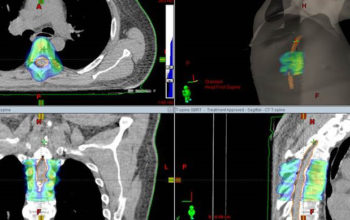Primary Brain Tumors
Brain tumors may originate from any cell type in the brain including its coverings and supporting tissues such as blood vessels (Hemangiomas), lymph vessels (Lymphomas), meninges (Meningiomas), cranial nerves (Neurinomas), pituitary gland (Pituitary Adenomas) and pineal gland (Pinealomas). Brain tumors from glial cells (Gliomas) are the most common primary brain tumors, affecting approximately 6 per 100,000 person-years in the United States.
Brain tumors are invasive and grow in a limited space within the intracranial cavity. Because of their location, treatment should often not be delayed. Rarely, brain tumors in non-critical areas which grow very slowly may simply be observed and followed with imaging studies such as CT or MRI.

Conventional MRI is the most effective imaging modality in the work-up of CNS tumors. Radiation therapy may be recommended in three circumstances:
- – Radiation can be given after surgery for residual disease.
- – Radiation may be the preferred treatment when a low-grade glioma has been diagnosed in a critical area of the brain that cannot be surgically removed, and therapy is felt to be necessary.
- – Radiosurgery is an emerging modality of treatment that can be used either for cure, retreatment or salvage after conventional radiation.
Radiosurgery
Stereotactic radiosurgery (SRS) is a technique that allows destruction of an intracranial tumor using focal radiation with stereotactic guidance while protecting normal brain from unwanted radiation.
Many benign brain tumors can be treated with radiosurgery without the need for open surgery, craniotomy or other invasive procedures. Malignant tumors usually require surgical excision or biopsy. Nowadays many surgical treatments tend to be minimally invasive such as stereotactic guided biopsies.
Low grade astrocytomas (LGA) are slow-growing primary brain tumors with a heterogeneous clinical behavior, for which the management remains controversial. Treatment approaches range from early and extensive surgery versus “wait-and-see”, and radiation immediately after surgery versus at the time of progression.

Brain Metastases
Brain metastases are neoplasms that originate in tissues outside the brain and spread secondarily to involve the brain. Metastases to the brain may be single or multiple. It is estimated that more than 200,000 new cases of brain metastases occur in the United States each year. Lung cancer, the leading cause of cancer deaths in the United States, and breast cancer, the most common cancer in women, are responsible for more than half of the cases of brain metastases in the United States.

Spine Metastases
Spinal metastases represent a common problem affecting more than 200,000 patients a year in the United States. For many years, conventional radiation therapy has been the most common treatment for patients with metastatic spinal tumors.
